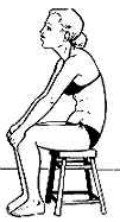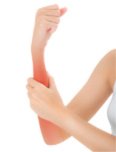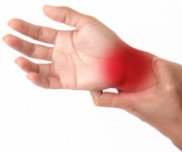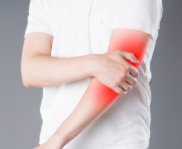Adhesions and Fascia -
The Real Source of Your Injury
Adhesions form in the fascial matrix where the fascia has been under unusual stress. The fascia undergoes a chemical change and becomes sticky. Layers of fascia begin to glue together, impeding normal tissue movement and muscular contraction. Sticking points that form along the sheaths that protect nerves can then glue the nerve to a neighboring structure causing constant irritation of that nerve.
Adhesions are often categorized as scar tissue. But for our purposes on this website, I will describe them separately. The distinction I make between the two is that scar tissue tends to be very dense and forms as a result, most often, from cutting as in surgery. Of course, scar tissue can also develop as a result of other tears in the body's tissue.
These bonding patterns occur all the time, often because of how we use our bodies. They can be much finer, smaller and less limiting, and they can also be large, involving broad swaths of interconnecting muscle along a fascial meridian. But don't get me wrong. They are a major source of problems in any case of repetitive strain injury!
Adhesions and Fascial Meridians
Fascia is often found in sheet-like planes. These sheets of fascia tend to separate groups of muscles from one another, and will often extend great distances through the body. For example, there are planes of fascia that extend from the fingertips of the right hand to the fingertips of the left hand, through the shoulder girdle.
These planes of tissue are also sometimes known as fascial meridians. They extend through long lines in the body and transmit movement and other sensory information along the meridian. When any part of the meridian is adhered, the effect of the limitation is felt throughout the entire meridian.
When adhesions form along these sheets of fascia, symptoms feel like they cover a broad area. It is hard to pinpoint exactly where the pain is located. This is very common in areas of the body where muscles run parallel to one another as in the forearms.
Muscles will sometimes become bonded to one another in a functional group along a seam of fascia running between them. When muscles are glued to one another in this way, normal contraction of each muscle becomes limited. They simply can't work as well when glued to a neighbor. These types of limitations can prevent you from turning your head as fully as you used to, or lifting your arm high overhead, for example.
Adhesions In Deep Muscular Fascia
Fascia that penetrates throughout muscle, surrounding individual muscle fibers, causes a different kind of problem when it becomes compromised.
Adhesions in the deep muscular fascia tends to limit the ability of the muscle to contract, making it function and feel weaker. If you have developed a weakness in your forearm muscles, for example, it is likely due to bonded areas deep in the belly of the muscle that may also be paired with adhesions in the seams of fascia between the muscles.
Adhesions Affecting Nerves and Blood Vessels
So how do nerves and blood vessels become entrapped?
Part of the time, nerves and blood vessels (which tend to be located in the same general areas with one another) run parallel to muscles, near their surface. In this case, adhesions in the fascial planes surrounding the muscles can become glued to the fascial sheaths that wrap the nerves and blood vessels. When this happens, the normal sliding and gliding of the nerves and blood vessels becomes significantly limited and they tend to get tugged and irritated as the contraction of the muscle pulls them along.
Fascial sheaths around the nerves and blood vessels can also become bonded to the fascia running through the middle of the muscle so that any time the muscle contracts, the nerves and blood vessels get tugged and irritated.
Over time, this heightened stimulation of the nerves becomes chronic causing the kind of nerve-related symptoms commonly seen in carpal tunnel syndrome, thoracic outlet syndrome and ulnar (cubital) tunnel syndrome. The blood vessels that are traveling alongside the nerves can also become squeezed, limiting the amount of circulation that passes through them, although this is a much more rare occurrence.
Here's a challenging situation. A nerve can be stuck anywhere along its pathway and may cause symptoms in another location. A prime example of this is in carpal tunnel syndrome where the nerve is often glued to other tissue in the armpit but the symptoms are felt at the wrist.
Adhesions Are The Record of Habitual Movement Patterns

Human beings are creatures of habit. We tend to do things one way and seldom vary that way, even when it becomes uncomfortable. If that movement is stressful to the body in any way, the fascia responds, molding itself to reflect our desired movement pattern. This change in the fascia makes it feel more "normal" to do things the way you have always done them and reinforces our habit.
Here is an example of how your fascia records the way you use your body.
Cross your arms in front of your chest as you normally would. Notice which arm ends up on top. Now, cross your arms the other way, with the other arm ending up on top. Notice how different and unnatural that feels. The reason why is because over the course of your life, you have tended to cross your arms one way and the fascia in the arms and shoulders have recorded that preference. The fascia has shortened and chemically changed to reflect that habit.
The same holds true for all other movement patterns adapted because of poor posture, or the limitations that develop after a broken bone, surgery, or other trauma...any kind of stress.
These adaptations can even form because you habitually use the same muscles (and fascia) at both work and play. An example might be that you play tennis which requires a firm grip on your racket and your job also requires that you grip tools, or a steering wheel. Fascia molds itself to reflect the condition and use of your body, especially the habitual and stressful uses of your body.
The Effects of Gravity on Adhesions

Gravity tends to put additional strain on tissue that is not properly aligned.
All the elements of your body have a natural alignment to each other and to the field of gravity. When that alignment is disturbed because you slouch, or raise your shoulders unconsciously, or lean to one side because you habitually carry a heavy bag on that side, gravity pulls you down even more.
As gravity pulls down, your body needs additional support to hold you up. So, to help, fascia undergoes a chemical change to thicken, tighten and offer more support. Unfortunately, the thickened fascia also tends to be sticky which leads to the formation of adhesions. This is why, for some people, improving their posture can be a very helpful part of the recovery process.
Adhesions Can Grow
Once an adhesion forms, it becomes, in itself, another form of additional stress to your body.
You adapt by forming more bonds between muscles and other tissues, becoming even more stressful to your body. The effect of these distortions spreads throughout your body. And because much of the fascia in your body is found in the long and extended fascial meridians, the effects of those adhesions can extend far and wide throughout your body.
Often, symptoms of your repetitive strain injury are caused by compromised tissues affecting parts of your body that you wouldn't think are connected to your injury. For example, deep aching in the wrist is often caused by fascial limitations in one of the major back muscles. How is that happening? The effects of the bonding in the back muscle are spreading all the way down the arm to the wrist along a fascial meridian. By releasing the fascia in the back muscle, the aching in the wrist goes away.
How and where adhesions form is the answer to the many and very confusing symptoms that come along with any repetitive strain injury. So many symptoms make no sense in the usual anatomical way of thinking about the body, and so many of them are missed, discounted as not having an impact on what you are feeling, or are simply ignored because the connections are not understood.
But, when you can learn how to find, recognize and eliminate the effect of these glued tissues, your symptoms will improve quickly, safely and naturally.
Visit these related pages for more information:
Fascia - What You Don't Know Is Hurting You
Fascia Anatomy - Understanding Your Opponent
Scar Tissue - Previous Injuries Add To Your Pain
Stretching Fascia - The Ultimate Injury Solution
Click the block below that most closely matches your injury for more information and to find the Toolkit we offer to help you in your recovery.







